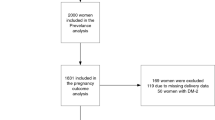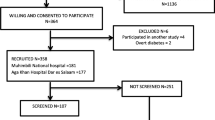Abstract
Objective
To compare the incidence, maternal and fetal outcomes of gestational diabetes mellitus using one step versus two steps as a screening procedure.
Methodology
A prospective randomized trial involving screening of 1000 pregnant women for gestational diabetes mellitus was conducted. Women were divided in two groups (500 each). Group A comprised of patients screened with two-step approach (ACOG recommendation), and group B comprised of women screened by one-step method (IADPSG criteria). Women diagnosed with ‘gestational diabetes’ were followed in an antenatal clinic, and incidence of GDM and maternal and fetal outcome between two groups were analyzed using SPSS.
Results
The incidence of GDM was almost double using one-step versus two-step approach which was 19.2 and 11.8%, respectively. Maternal outcomes were comparable in both the groups except the risk of preterm delivery which was 2.5 times more in group A than group B (odds ratio = 2.43 95% CI 1.01–5.79). Further, fetal outcomes were also comparable except neonatal hypoglycemia which was seen in 29.31% in group A versus 7.4% in group B. In the group B, 15 patients (15.8%) with GDM (based on FBS ≥ 92 mg/dl at first ANC visit) showed clinical symptoms and blood sugars in hypoglycemic range on MNT requiring resumption of normal diet.
Conclusion
The incidence of GDM using IADPSG criteria was almost double versus ACOG criteria. Maternal and fetal outcomes were comparable except in 15.8% women diagnosed as GDM (using FBS ≥ 92 mg/dl at first ANC visit as per IADPSG) and suffered from hypoglycemia. A large trial is being proposed before these criteria are adopted.

Similar content being viewed by others
References
American Diabetes Association. Diagnosis and classification of diabetes mellitus (position statement). Diabetes Care. 2009;32:S62–7.
Gestational Diabetes Mellitus. Clinical management guidelines for obstetricians-gynecologist. Practice Bulletin No. 137 (Replaces Practice Bulletin Number 30, September 2001, Committee opinion Number 435, June 2009, and Committee Opinion Number 504, September 2011) American College of Obstetricians and Gynaecologists. Obstet Gynecol. 2013;2013(122):406–16.
Alberti K, Zimmett P. Definition, diagnosis and classification of diabetes mellitus and its complications. Part 1: diagnosis and classification of diabetes mellitus provisional report of a WHO consultation. Diabetes Med. 1998;15:539–53.
International Association of Diabetes and Pregnancy Study Groups Consensus Panel. International Association of Diabetes and Pregnancy Study Groups recommendations on the diagnosis and classification of hyperglycemia in pregnancy. Diabetes Care. 2010;33:676–82.
Metzger BE, Lowe LP, Dyer AR, et al. Hyperglycemia and adverse pregnancy outcomes. N Engl J Med. 2008;358:1991–2002.
Seshiah V, Sahay BK, Das AK, et al. Gestational diabetes mellitus—Indian guidelines. J Indian Med Assoc. 2009;107:799–806.
Wahi P, Dogra V, Jandial K, et al. Prevalence of gestational diabetes mellitus (GDM) and its outcomes in Jammu region. J Assoc Physicians India. 2011;59:227–30.
Agarwal MM, Dhatt GS, Shah SM. Gestational diabetes mellitus. Diabetic Care. 2010;33:2018–20.
Cheng YW, Block-Kurbisch I, Caughey AB. Carpenter–Coustan criteria compared with the national diabetes data group thresholds for gestational diabetes mellitus. Obstet Gynecol. 2009;114:326–32.
Benhalima K, Hanssens M, Devlieger R, et al. Analysis of pregnancy outcomes using the new IADPSG recommendation compared with the Carpenter and Coustan criteria in an area with a low prevalence of gestational diabetes. Int J Endocrinol. 2013;2013:1–6.
Author information
Authors and Affiliations
Corresponding author
Ethics declarations
Conflict of interest
There is no conflict of interest.
Ethical Standard
All the procedures followed in study were in accordance with the ethical standards of institution, ethical committee of institution had critically evaluated the study and its methodology and given the approval before the study has been started.
Additional information
Dr. Mohit Satodiya is Senior resident in Department of Obstetrics and Gynecology at GMCH, Sector 32, Chandigarh 160030; Dr. Navneet Takkar is Associate Professor in Department of Obstetrics and Gynecology at GMCH, Sector 32, Chandigarh 160030; Dr. Poonam Goel is Professor in Department of Obstetrics and Gynecology at GMCH, Sector 32, Chandigarh 160030; Dr. Jasbinder Kaur is Professor and Head in Department of Biochemistry at Govt. Medical College and Hospital, Chandigarh 160030.
Rights and permissions
About this article
Cite this article
Satodiya, M., Takkar, N., Goel, P. et al. Comparison of One-Step Versus Two-Step Screening for Diagnosis of GDM in Indian Population: A Randomized Controlled Trial. J Obstet Gynecol India 67, 190–195 (2017). https://doi.org/10.1007/s13224-016-0955-2
Received:
Accepted:
Published:
Issue Date:
DOI: https://doi.org/10.1007/s13224-016-0955-2




